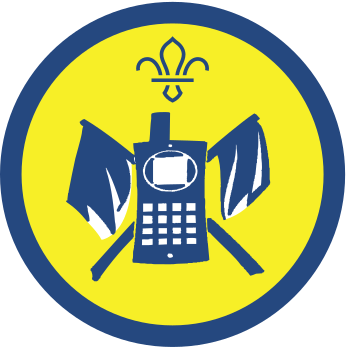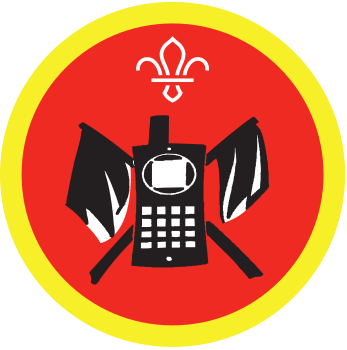Moonlit Morse
You’ll need
- Torch or phone
Before you begin
- Use the safety checklist to help you plan and risk assess your activity. Additional help to carry out your risk assessment, including examples can be found here. Don’t forget to make sure all young people and adults involved in the activity know how to take part safely.
- Make sure you’ll have enough adult helpers. You may need some parents and carers to help out if you’re short on helpers.
Setting up the activity
- Look through the ‘Torchlight Morse code’ sheet, so you understand the idea and can answer any questions the group may have.
Morse code is a code that uses dots and dashes to represent letters and numbers. It can be sent using light (like in this activity), sound (such as beeps, clapping, or tapping), or other methods such a blinking.
The most famous Morse code message is the SOS distress call of dot dot dot / dash dash dash / dot dot dot that’s used in emergencies.
Learn Morse code
- Separate everyone into small groups. If you can, it may be helpful to have an adult to help each group.
- Everyone should get a copy of the ‘Torchlight Morse code’ sheet and look at the code. If it’s already really dark, they should use their torches to help them.
- Explain that a dot is one unit long and a dash is three units long. The space between parts of the same letter is one unit, the space between letters is three units, and the space between words is seven units. You could count out loud to help you measure the units.
- The adult in each group should show how to use their torch to represent the dashes and dots. They should spell out a simple word, such as their name, as an example. Alternatively, a volunteer should show the whole group.
- If it’s tricky to turn the torch on and off quickly, you can just cover the lamp using your hand, your necker or a piece of card.
- Everyone should practise using their torch to send their name, using the ‘Torchlight Morse code’ sheet to help them. It’s up to them whether they turn the torch on and off or cover the lamp.
Send Morse messages
- Everyone should split into two teams that are the same size. If you've an odd number of people, a volunteer or young leader should join in. If you've a really big group, you may want to split into four even teams.
- Each team should decide on a word or short phrase that they want to send the other team. Their word or phrase should have the same number of letters as the number of people in the group. Small groups could use words, such as Scouts, outdoors, fun, or friends. Bigger groups may want to ask ‘How are you?’ or comment on the weather.
- Everyone should decide who’ll send each letter. They should use the ‘Torchlight Morse code’ sheet to learn their letter in Morse code.
- Each team should stand in a line in the right order for their word or phrase. The two teams should be opposite each other – everyone should be facing one person from the other team.
- The first person in one team should use their torch to send their letter. They should be careful not to flash their torch into the eyes of the person opposite them.
- The person opposite them should try to identify the letter and shout it out for everyone to hear.
- Everyone should continue spelling the word letter by letter, waiting for the person opposite them to identify the letter before moving on.
- Make sure everyone knows how long a gap to leave between each letter or word – they can count to themselves in a whisper if it helps. If it’s getting confusing, the person leading the activity could say whether the gap is between a letter or word.
- Once they’ve identified all of the letters, the team should put them together and shout out the word or phrase.
- The teams should swap over so the other team has a chance to send a word.
- When each team has worked out the other team’s word, congratulate everyone on learning some basic Morse code – what an achievement!
- If there’s time, the group could try to send more words or phrases. Can they make them trickier each time?
Reflection
This activity introduced everyone to the international system of Morse code, which has been around for almost two hundred years. How did everyone find learning Morse code using their torches? Were any letters particularly hard to remember or send?
Learning how to communicate great distances without using words or modern technology is a great survival skill – congratulate everyone on trying something new. When might people use Morse code? Can anyone remember how to send any of the letters in ‘well done’?
Safety
All activities must be safely managed. You must complete a thorough risk assessment and take appropriate steps to reduce risk. Use the safety checklist to help you plan and risk assess your activity. Always get approval for the activity, and have suitable supervision and an InTouch process.
- Dark
Provide some light, so the environment isn’t completely dark. Everyone must be able to see others and move around the area safely.
- If anyone is finding it tricky to work out what letter the torch flashes mean, they could ask other members of the group to help as long as they stay socially distanced.
- If anyone struggles to time the gaps between their dots and dashes, they could shout out how long the gap is (three or seven units). You could also say when you switch to a new word.
- If teams are struggling to put a word or phrase together, someone could jot down the letters as they’re shouted out.
- Make sure everyone’s at the same level so they can see easily – you could all sit on chairs, for example.
- Make sure you support with spelling if anyone needs it. Help get everyone into their correct place in the line to spell their word or phrase – some tricky letters are easy to get mixed up.
All Scout activities should be inclusive and accessible.
You could take this further by seeing if the group can remember how to ‘flash’ their name in Morse code without using anything to help in the next session.
Let the young people choose what word or short phrase they want to send.

